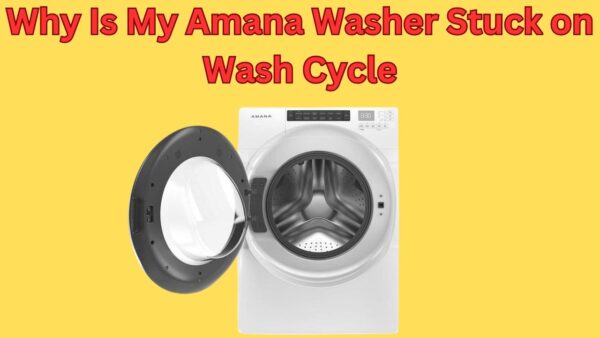Hi dear friends welcome to our blog. If your Washing Machine Pulls Threads in My Clothes.
So Don’t worry this is a common issue.
In this guide, we explain 10 common reasons for this problem with unique solutions. So let’s start now.
Why Is My Washing Machine Pulling Threads in My Clothes

1. Overloading the Machine
Cause
Overloading your washing machine is one of the most common causes of thread pulling in clothes.
By stuffing too many garments into the machine, you’re preventing the clothes from moving freely.
This causes excessive friction between clothes, leading to the threads in your clothes getting pulled or stretched.
Solution
The solution to this issue is simple yet effective: Do not overload your washing machine. Always ensure that your clothes have enough room to tumble freely.
A good rule of thumb is to fill the machine to about three-quarters full, no more.
This not only prevents the threads in your clothes from pulling but also ensures that your clothes get thoroughly cleaned.
2. Using the Wrong Detergent
Cause
Using the wrong detergent can lead to a multitude of issues with your laundry.
For instance, it could cause damage to your clothing materials, fading colors, and reducing the lifespan of delicate fabrics.
It might also lead to buildup in your washing machine, affecting its performance over time.
Critical to remember is that different fabrics require detergents with different pH levels and chemical compositions.
Solution
To avoid these problems, it’s essential to choose the correct detergent for your laundry. Always read the labels on your clothing and the detergent packaging to ensure they’re compatible.
Furthermore, regularly clean your washing machine to prevent detergent buildup.
Choosing a detergent that is specifically designed for your fabric type and washing machine can make a significant difference in maintaining the quality of your clothing and the longevity of your machine.
3. Damaged Drum
Cause
Drum damages primarily occur due to improper handling, loading, or transportation.
It’s common for drums to be mishandled during loading or unloading, resulting in dents, cracks, or loosening of the drum head.
Environmental factors such as temperature fluctuations or humidity can also contribute to the warping or distortion of drum shells, affecting the overall sound quality.
Solution
To mitigate drum damage, ensure careful handling during transportation, and proper storage in a temperature-controlled environment.
Invest in durable cases for added protection when transporting drums. If damage occurs, consider seeking professional repair services.
For minor damages, drum heads can usually be replaced, but cracks in the drum shell may require more extensive repairs.
Regular maintenance and immediate action upon noticing damages can significantly prolong the lifespan of a drum.
4. Unbalanced Load
Causes
An unbalanced load primarily occurs when the electrical loads are not equally distributed across all phases of a power system.
Common causes include uneven distribution of appliances across the phases, single-phase loads on a three-phase system, or loads with differing power factors.
This imbalance can lead to a range of problems such as excessive heat, premature equipment failure, and increased energy costs.
Solutions
Addressing unbalanced loads requires a systematic approach that starts with an electrical system audit. Identifying and redistributing single-phase loads evenly across the phases is one of the most effective solutions.
The use of a load-balancing transformer can also help in managing the power distribution.
Besides, preventive maintenance and regular monitoring of the power system can significantly prevent the occurrence of unbalanced loads.
5. Incorrect Temperature Setting
Cause
The root cause of incorrect temperature settings often lies in faulty thermostats.
A miscalibrated thermostat might not correctly interpret the ambient temperature, causing heating or cooling systems to work insufficiently or excessively.
Further, improper placement of the thermostat, such as near heat sources or drafts, can lead to inaccurate readings.
Remember, the placement and calibration of your thermostat play crucial roles in maintaining desired temperatures.
Solution
To rectify incorrect temperature settings, start by checking the calibration of your thermostat. Refer to the manufacturer’s instructions or hire a professional if necessary.
Next, evaluate the placement of your thermostat. It should be away from windows, doors, and heat sources for accurate readings. In some cases, a thermostat replacement might be necessary.
Regular maintenance and proper setup of your thermostat are key to optimal temperature settings.
6. Worn Out Tub Bearings
Cause
Tub bearings, an integral component of a washing machine, can wear out over time due to continuous usage and heavy loads.
The constant rotation and the weight they bear can lead to wear and tear.
This deterioration is often indicated by a loud noise during the spin cycle. The persistent noise is a clear sign of worn-out tub bearings.
Solution
The best solution for worn-out tub bearings is to replace them. It’s advisable to call a professional technician to handle this task, as it can be quite complex and requires specific tools.
A professional repair ensures the safety and longevity of your washing machine.
However, always consider the age and overall condition of your machine before investing in major repairs.
Sometimes it may be more economical to replace the unit. Consider all factors before deciding between repair or replacement.
7. Using Too Much Fabric Softener
Cause
Using too much fabric softener can lead to a variety of issues. It can leave a noticeable and unwanted residue on your clothes, making them feel slick or greasy.
This residue can also reduce the absorbency of certain fabrics like towels.
Also, excess fabric softener can build up in your washing machine over time, leading to reduced effectiveness and possible mechanical issues.
Solution
The solution to this is simple: use less fabric softener. Measure out the recommended amount of fabric softener prior to each wash cycle, rather than guessing the amount.
If you find that your clothes are still not as soft as you’d like, try adding a cup of white vinegar to the rinse cycle.
This can help to soften clothes and remove any residual build-up of fabric softener in the washing machine.
Regular maintenance of your washing machine is also essential to prevent the accumulation of excess fabric softener.
8. Zippers or Buttons Causing Snags
Cause
Zippers and buttons can cause snags in various types of fabric due to their metal or plastic edges which might catch onto loose threads or weaves.
This is particularly common in delicate materials like silk, satin, or knitwear.
Friction or pressure applied while fastening or unfastening can pull these threads, leading to noticeable snags or even tears in the fabric.
The risk of snags is especially high when clothing is improperly handled or hastily worn or removed.
Solution
Preventing snags caused by zippers or buttons involves careful handling and certain precautions. Always ensure to fully unfasten buttons or zippers before dressing or undressing.
When washing clothes, consider using a laundry bag for items with zippers or buttons.
It’s also helpful to fasten all closures before washing to prevent them from catching onto other items.
Using fabric-friendly materials, like plastic zippers or cloth-covered buttons, can significantly reduce the risk of snags.
9. Using the Wrong Wash Cycle
Cause
When we use the wrong wash cycle, it can cause damage to our clothes. Often the mistake arises from not understanding the different settings on our washing machines.
Some garments may shrink, color may bleed, or fabric may be worn out if subjected to a cycle they aren’t designed to withstand.
Solution
To avoid these issues, it’s essential to understand the function of each wash cycle and match it to the type of fabric being washed.
Consult the garment’s care instructions which typically provide recommended wash settings.
For further guidance, refer to your washing machine’s manual or explore online resources.
Remember, using the correct wash cycle not only preserves your clothes but also enhances your washing machine’s longevity.
10. Detergent Residue Buildup
Cause
Detergent residue buildup often occurs when excess detergent is used while doing laundry.
This surplus detergent does not fully rinse out during the wash cycle and accumulates over time on your clothes and inside the washing machine.
The buildup can lead to laundry that is not thoroughly cleaned and a machine that may not function optimally. It can also cause unpleasant odors and skin irritations.
Excess detergent use, insufficient rinse cycles, and inappropriate detergents are common causes of detergent residue buildup.
Solution
To solve the issue of detergent residue buildup, firstly, ensure you’re using the correct amount of detergent—less is often more.
Secondly, consider adding an extra rinse cycle to your laundry routine to help fully remove detergent.
Lastly, use a washing machine cleaner every few months to clean out any lingering buildup inside the machine.
Regular maintenance, appropriate detergent usage, and extra rinse cycles are effective solutions to detergent residue buildup.
Conclusion
It is evident that the swift advancement of technology represents a breakthrough in numerous sectors, including education, transportation, and healthcare.
The introduction of high-speed internet and powerful computing devices has paved the way for a generation where knowledge is just a click away, travel is more efficient and safer, and medical treatments are more advanced and effective.
However, it is crucial to navigate these advancements with caution, ensuring that they serve to augment human capabilities, promote equality, and sustain our environment rather than compromise them.
FAQs
Q: Why is my washing machine snagging my clothes?
A: Your washing machine could be snagging clothes due to a broken drum or agitator, or sharp objects left in clothing pockets.
Q: How do I stop my washing machine from damaging my clothes?
A: Ensure to remove all sharp objects from pockets, use a laundry bag for delicate items, and avoid overloading the machine.
Q: How do I stop my washing machine from ruining my clothes?
A: Regularly inspect and maintain your machine, use the right detergent, and sort your clothes properly before washing.
Indesit Washing Machine Won T Start Cycle
How to Prevent Clothes From Getting Stuck Under Agitator
Washing Machine Will Not Agitate but Will Spin and Drain
Dryer Just Buzzes When Start Button Pushed
Kenmore Dryer Keeps Shutting Off
Miele Dishwasher Red Light Flashing
Washing Machine Drainage Options
Miele W1 Stuck on Program Cancelled
Why Is My Washing Machine Using Hot Water Instead of Cold
Slow Water Flow in Washing Machine


Name: Joseph Title: Owner and Founder Website: myappliancegeek.com
Biographical Info:
Joseph, the creative mind and founder behind myappliancegeek.com is a distinguished expert in the field of home appliances and technology.
Education: Joseph holds a prestigious degree in Appliance Engineering from a renowned institution in the United States, [Stanford University], where he gained a profound understanding of appliance design, mechanics, and technology.
Professional Experience: Joseph’s professional journey spans over [18 ] years in the home appliance industry. His extensive experience includes working with industry-leading appliance manufacturers, prominent retailers, and appliance repair services.
Entrepreneurship: In [2000], Joseph founded myappliancegeek.com, a platform dedicated to providing comprehensive information, advice, and solutions for those seeking guidance in the world of appliances.
Passion for Appliances: Joseph’s unwavering passion for home appliances stems from his belief in their pivotal role in improving our quality of life.
Contributions to the Industry: Joseph’s commitment to the home appliance industry is evident through his extensive writing and speaking engagements.
Community Involvement: Joseph is not only an online presence but also an active member of the community, frequently engaging in outreach programs, local workshops, and charitable initiatives.


